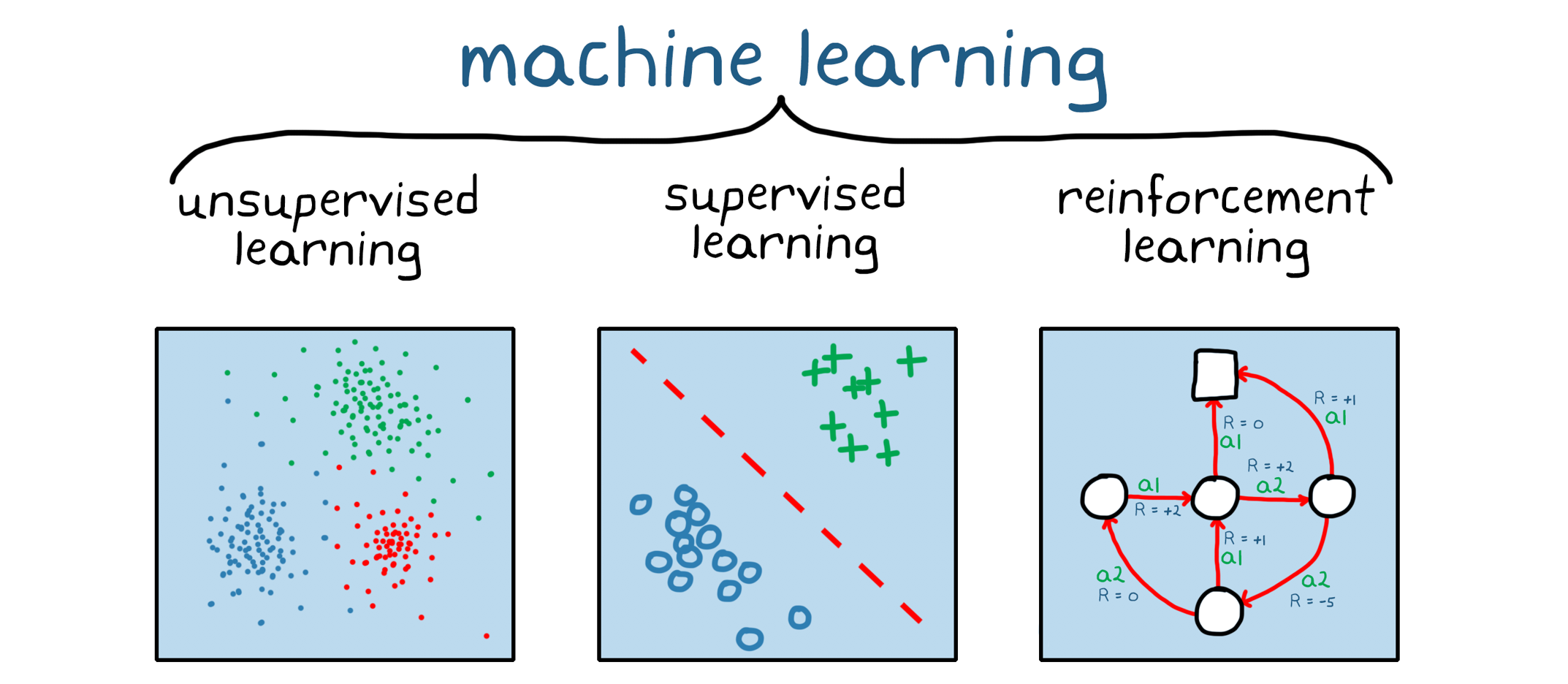Reinforcement Learning Notes
Reinforcement Learning Notes
Recap of RL Mathematics
Basics
🐾 Basics take the Non-incremental Form, Tabular Representation, and are Value-based.
Bellman Equation
\[G_t = R_{t+1} + \gamma G_{t+1}\]State Value and Action Value
\[\begin{align} \textcolor{red}{v_{\pi}(s)} &= \mathbb{E}[G_t \vert S_t = s] \nonumber\\ &= \mathbb{E}[R_{t+1} \vert S_t = s] + \gamma \mathbb{E} [G_{t+1} \vert S_t = s] \nonumber\\ &= \sum_{a \in \mathcal{A}} \pi (a \vert s) [\sum_{r \in \mathcal{R}} p(r|s, a) r + \gamma \sum_{s' \in \mathcal{S}} p(s' \vert s, a) v_{\pi}(s') ], \textcolor{green}{\forall s \in S}. \nonumber\\ &= \sum_{a \in \mathcal{A}} \pi (a \vert s) \textcolor{red}{q_{\pi}(s, a)} \nonumber \end{align}\]Bellman Optimality Equation
\[\begin{align} v_{\pi}(s) &= \textcolor{red}{\max_{\pi}} \sum_{a} \textcolor{red}{\pi (a \vert s)} (\sum_{r} p(r|s, a) r + \gamma \sum_{s'} p(s' \vert s, a) v_{\pi}(s')) \nonumber\\ & = \textcolor{red}{\max_{\pi}} \sum_{a} \textcolor{red}{\pi (a \vert s)} q(s, a) \nonumber \end{align}\]Sovling Bellman Optimality Equation
Model-based
\[\begin{alignat}{2} v_{\pi 1}^{(0)} &= v_0 \nonumber\\ v_{\pi 1}^{(1)} &= r_{\pi 1} + \gamma P_{\pi 1} v_{\pi 1}^{(0)} &&\longrightarrow v_1 \longrightarrow \text{Value Iteration} \nonumber\\ v_{\pi 1}^{(2)} &= r_{\pi 1} + \gamma P_{\pi 1} v_{\pi 1}^{(1)} \nonumber\\ \vdots \nonumber\\ v_{\pi 1}^{(j)} &= r_{\pi 1} + \gamma P_{\pi 1} v_{\pi 1}^{(j-1)} &&\longrightarrow \bar{v}_1 \longrightarrow \text{Truncated Policy Iteration} \nonumber\\ \vdots \nonumber\\ v_{\pi 1}^{(\infty)} &= r_{\pi 1} + \gamma P_{\pi 1} v_{\pi 1}^{(\infty)} &&\longrightarrow v_{\pi 1} \longrightarrow \text{Policy Iteration} \nonumber \end{alignat}\]Model-free
Monte Carlo
\[\begin{alignat}{2} q_{\pi}(s, a) &= \mathbb{E}[G_t \vert S_t = s, A_t = a] &&\longrightarrow \text{Model-free} \nonumber\\ &= \sum_{r} p(r|s, a) r + \gamma \sum_{s'} p(s' \vert s, a) v_{\pi}(s') &&\longrightarrow \text{Model-based} \nonumber \end{alignat}\]- Policy Evaluation: Estimate \(q_{\pi_k}(s, a)\) directly, instead of sovling \(v_{\pi_k}(s)\)
- Policy Improvement: Same as Policy Iteration
Incrementral Form
🐾 Shifting from the Non-incremental Form to the Incremental Form.
TD Learning
Stochatic Approximation.
\[\underbrace{v_{t+1}(s_t)}_{\text{New Estimation}} = \underbrace{v_t(s_t)}_{\text{Current Estimation}} - \alpha_t(s_t) \overbrace{[v_t(s_t) - \underbrace{(r_{t+1} + \gamma v_t(s_{t+1}))}_{\text{TD Target }\bar{v}_t}]}^{\text{TD Error } \delta_t}\]A special Stochastic Approximation algorithm for estimating State Value.
Sarsa
\[\begin{align} q_{t+1}(s_t, a_t) &= q_t(s_t, a_t) - \alpha_t(s_t, a_t) [q_t(s_t, a_t) - [r_{t+1} + \gamma q_t(s_{t+1}, a_{t+1})]] \nonumber\\ q_{t+1}(s, a) &= q_t(s, a), \forall (s, a) \neq (s_t, a_t) \nonumber \end{align}\] \[\begin{alignat}{2} G_t &= \gamma^{0}R_{t+1} + \gamma^{1}q_{\pi}(S_{t+1}, A_{t+1}) &&\longrightarrow \text{Sarsa} \nonumber\\ G_t &= \gamma^{0}R_{t+1} + \gamma^{1}R_{t+2} + \gamma^{2} q_{\pi}(S_{t+2}, A_{t+2})\nonumber\\ &\vdots \nonumber\\ G_t &= \gamma^{0}R_{t+1} + \gamma^{1}R_{t+2} + \cdots + \gamma^{n}q_{\pi}(S_{t+n}, A_{t+n}) &&\longrightarrow n\text{-Step Sarsa} \nonumber\\ &\vdots \nonumber\\ G_t &= \gamma^{0}R_{t+1} + \gamma^{1}R_{t+2} + \gamma^{2}R_{t+3} + \cdots &&\longrightarrow \text{Monte Carlo} \nonumber \end{alignat}\]TD Learning for Action Value.
Q-Learning
\[\begin{align} q_{t+1}(s_t, a_t) &= q_t(s_t, a_t) - \alpha_t(s_t, a_t) [q_t(s_t, a_t) - [r_{t+1} + \gamma \max_{a \in \mathcal{A}}(s_{t+1}, a)]] \nonumber\\ q_{t+1}(s, a) &= q_t(s, a), \forall (s, a) \neq (s_t, a_t) \nonumber \end{align}\]TD Learning for Optimal Action Value.
Function Representation
🐾 Shifting from the Tabular Representation to the Function Representation.
DQN
\[\begin{align} J(w) &= \mathbb{E}[(R + \gamma \max_{a \in \mathcal{A}(S')}\textcolor{red}{\hat{q}(S', a, w)} - \textcolor{blue}{\hat{q}(S, A, w)})^2] \nonumber \\ J(w) &= \mathbb{E}[(R + \gamma \max_{a \in \mathcal{A}(S')}\textcolor{red}{\hat{q}(S', a, w_T)} - \textcolor{blue}{\hat{q}(S, A, w)})^2] \nonumber \end{align}\] \[\nabla_w J(w) = \mathbb{E} [(R + \gamma \max_{a \in \mathcal{A}(S')} \textcolor{red}{\hat{q}(S', a, w_T)} - \textcolor{blue}{\hat{q}(S, A, w)}) \nabla_w \textcolor{blue}{\hat{q}(S, A, w)}] \nonumber\]- DQN use the target network \(\textcolor{red}{\hat{q}(S', a, w_T)}\) and the main network \(\textcolor{blue}{\hat{q}(S, A, w)}\)
- \(w\) updates constantly while \(w_T\) updates periodically
Policy-based
🐾 Shifting from the Value-based to the Policy-based.
Actor-Critic Method
QAC
A2C
Off-Policy Actor-Critic
Deterministic Policy Gradient (DPG)
Papers
Q-Learning
TD Learning
TD(\(\lambda\))
Actor-Critic
DQN
TRPO
A3C
PPO
This post is licensed under CC BY 4.0 by the author.
